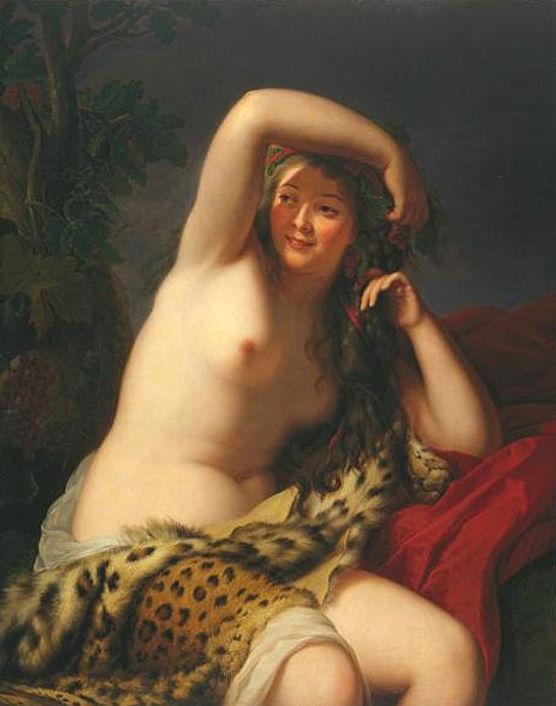
Rococco - IV
Jean-Baptiste Greuze
1725 - 1809
Jean-Baptiste Greuze (French pronunciation: [ʒɑ̃ batist ɡʁøz], 21 August 1725 – 4 March 1805) was a French painter of portraits, genre scenes, and history painting.
Greuze was born at Tournus, a market town in Burgundy. He is generally said to have formed his own talent; at an early age his inclinations, though thwarted by his father, were encouraged by a Lyonnese artist named Grandon, or Grondom, who enjoyed during his lifetime considerable reputation as a portrait-painter. Grandon not only persuaded Greuze's father to give way to his son's wishes, and permit the boy to accompany him as his pupil to Lyon, but, when at a later date he left Lyon for Paris, Grandon carried young Greuze with him.
Settled in Paris, Greuze worked from the living model in the school of the Royal Academy, but did not attract the attention of his teachers; and when he produced his first picture, Le Père de famille expliquant la Bible a ses enfants, considerable doubt was felt and shown as to his share in its production. By other and more remarkable works of the same class Greuze soon established his claims beyond contest, and won the notice and support of the well-known connoisseur La Live de Jully, the brother-in-law of Madame d'Epinay. In 1755 Greuze exhibited his Aveugle trompé, upon which, presented by Pigalle the sculptor, he was immediately agréé by the Academy.
Towards the close of the same year, he left France for Italy, in company with the Abbé Louis Gougenot. Gougenot had some acquaintance with the arts, and was highly valued by the Academicians, who, during his journey with Greuze, elected him an honorary member of their body on account of his studies in mythology and allegory; his acquirements in these respects are said to have been largely utilized by them, but to Greuze they were of doubtful advantage, and he lost rather than gained by this visit to Italy in Gougenot's company. He had undertaken it probably in order to silence those who taxed him with ignorance of great models of style, but the Italian subjects which formed the entirety of his contributions to the Salon of 1757 showed that he had been put on a false track, and he speedily returned to the source of his first inspiration.

Self-portrait

The Guitarist
1757

The White Hat
1780

The Broken Vessel
1771-1772

The Lazy Boy
1755

Mme Georges Gougenot de Croissy, née Vïrany de Varennes
1757

The Laundress (La Blanchisseuse)
1761

W. A. Mozart
1763–64

The Father's Curse
1770

Portrait of Count Stroganov as a Child
1778

Broken Eggs
1756

Cupid Crowned by Psyche
1785-1790

Jeanne Philiberte Ledoux,
c. 1790

Nicolas-Pierre-Baptiste Anselme
c. 1790

The Two Friends

Portrait of Marquise de Chauvelin

The young mathematician

The Broken Mirror
1763

Girl with Birds
1780-82

Indolence (La Paresseuse Italienne)
1756
Thomas Gainsborough
1727 - 1788
Thomas Gainsborough (/ˈɡeɪnzbərə/; 14 May 1727 (baptised) – 2 August 1788) was an English portrait and landscape painter, draughtsman, and printmaker. Along with his rival Sir Joshua Reynolds, he is considered one of the most important British artists of the second half of the 18th century. He painted quickly, and the works of his maturity are characterised by a light palette and easy strokes. Despite being a prolific portrait painter, Gainsborough gained greater satisfaction from his landscapes. He is credited (with Richard Wilson) as the originator of the 18th-century British landscape school. Gainsborough was a founding member of the Royal Academy.
Gainsborough was born in Sudbury, Suffolk, the youngest son of John Gainsborough, a weaver and maker of woolen goods, and his wife Mary, sister of the Reverend Humphry Burroughs. One of Gainsborough's brothers, Humphrey, is said to have invented the method of condensing steam in a separate vessel, which was of great service to James Watt; another brother, John, was known as Scheming Jack because of his passion for designing curiosities.
The artist spent his childhood at what is now Gainsborough's House, on Gainsborough Street, Sudbury. He later resided there following the death of his father in 1748 and before his move to Ipswich. The building is now a house-museum dedicated to his life and art.
As a boy he demonstrated impressive drawing and painting skills. At the age of ten he was painting heads and small landscapes, including a miniature self-portrait. Gainsborough left home in 1740 to study art in London, where he trained under engraver Hubert Gravelot but became associated with William Hogarth and his school. He assisted Francis Hayman in decorating the supper boxes at Vauxhall Gardens.

Self-portrait
1759

Mr and Mrs Andrews
1748-49

Portrait of Mrs Elizabeth Edgar
1750s

Landscape in Suffolk
c. 1750

The Artist's Wife
c. 1758

The Artist's Daughters with a Cat
1759-61

Lady Alston
1760-65
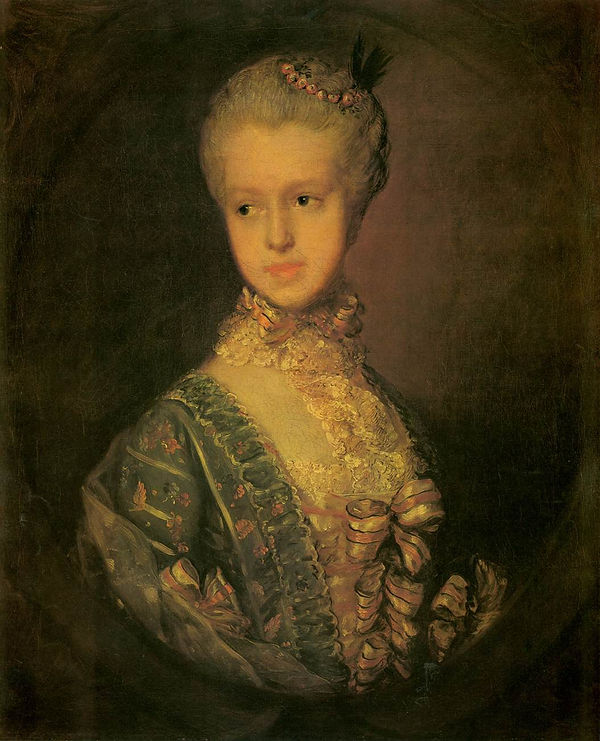
Elizabeth Wrottesly
1764-65

Mary, Countess of Howe
1764

Elizabeth and Thomas Linley
c. 1768

Master John Heathcote
1770

Johann Christian Bach
1776

Portrait of Sarah Buxton
1776-77

Portrait of a Lady in Blue
1779-81
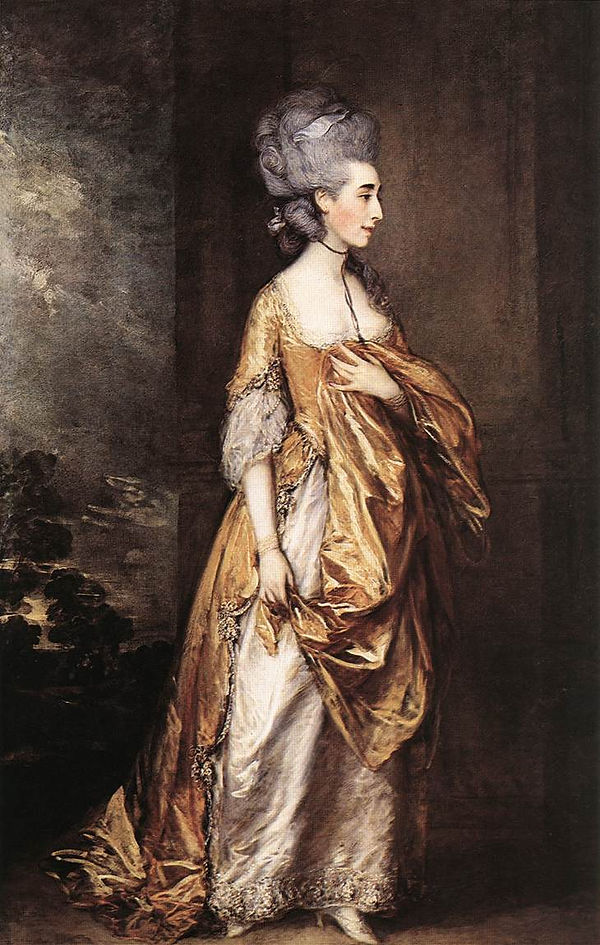
Mrs Grace Dalrymple Elliot
c. 1778

Mrs. Mary Robinson ("Perdita")
1781

Mr and Mrs William Hallett ('The Morning Walk')
1785

Mrs Sarah Siddons
1785

The Marsham Children
1787

The Blue Boy
1770
Jean-Honoré Fragonard
1732 –1806
Jean-Honoré Fragonard (5 April 1732 – 22 August 1806) was a French painter and printmaker whose late Rococo manner was distinguished by remarkable facility, exuberance, and hedonism. One of the most prolific artists active in the last decades of the Ancien Régime, Fragonard produced more than 550 paintings (not counting drawings and etchings), of which only five are dated. Among his most popular works are genre paintings conveying an atmosphere of intimacy and veiled eroticism.
Jean-Honoré Fragonard was born in Grasse, Alpes-Maritimes, France the only child of François Fragonard, a glover, and Françoise Petit. Fragonard was articled to a Paris notary when his father's circumstances became strained through unsuccessful speculations, but showed such talent and inclination for art that he was taken at the age of eighteen to François Boucher. Boucher recognized the youth's rare gifts but, disinclined to waste his time with one so inexperienced, sent him to Chardin's atelier. Fragonard studied for a short time with Chardin then returned more fully equipped to Boucher, whose style he soon acquired so completely that the master entrusted him with the execution of replicas of his paintings.
Though not yet a student of the Academy, Fragonard gained the Prix de Rome in 1752 with a painting of Jeroboam Sacrificing to Idols, but before proceeding to Rome he continued to study for three years under Charles-André van Loo. In the year preceding his departure he painted the Christ washing the Feet of the Apostles now at Grasse Cathedral. In December 1756, he took up his abode at the French Academy in Rome, then presided over by Charles-Joseph Natoire.
While at Rome, Fragonard contracted a friendship with a fellow painter, Hubert Robert. In 1760, they toured Italy together, executing numerous sketches of local scenery. It was in these romantic gardens, with their fountains, grottos, temples and terraces, that Fragonard conceived the dreams which he was subsequently to render in his art. He also learned to admire the masters of the Dutch and Flemish schools (Rubens, Hals, Rembrandt, Ruisdael), imitating their loose and vigorous brushstrokes. Added to this influence was the deep impression made upon his mind by the florid sumptuousness of Giovanni Battista Tiepolo, whose works he had an opportunity to study in Venice before he returned to Paris in 1761.
In 1765 his Coresus Sacrificing Himself to Save Callirhoe secured his admission to the Academy. It was made the subject of a pompous (though not wholly serious) eulogy by Denis Diderot, and was bought by the king, who had it reproduced at the Gobelins factory. Hitherto Fragonard had hesitated between religious, classic and other subjects; but now the demand of the wealthy art patrons of Louis XV's pleasure-loving and licentious court turned him definitely towards those scenes of love and voluptuousness, with which his name will ever be associated, and which are only made acceptable by the tender beauty of his color and the virtuosity of his facile brushwork; such works include the Blind Man's Bluff (Le collin maillard), Serment d'amour (Love Vow), Le Verrou (The Bolt), La Culbute (The Tumble), La Chemise enlevée (The Raised Chemise), and L'escarpolette (The Swing, Wallace Collection), and his decorations for the apartments of Mme du Barry and the dancer Madeleine Guimard.[6] The portrait of Diderot (1769) has recently had its attribution to Fragonard called into question.
A lukewarm response to these series of ambitious works induced Fragonard to abandon Rococo and to experiment with Neoclassicism. He married Marie-Anne Gérard, herself a painter of miniatures, (1745–1823) on 17 June 1769 and had a daughter, Rosalie Fragonard (1769–1788), who became one of his favourite models. In October 1773, he again went to Italy with Pierre-Jacques Onézyme Bergeret de Grancourt and his son, Pierre-Jacques Bergeret de Grancourt. In September 1774, he returned through Vienna, Prague, Dresden, Frankfurt and Strasbourg.
Back in Paris Marguerite Gérard, his wife's 14-year-old sister, became his student and assistant in 1778. In 1780, he had a son, Alexandre-Évariste Fragonard (1780–1850), who eventually became a talented painter and sculptor. The French Revolution deprived Fragonard of his private patrons: they were either guillotined or exiled. The neglected painter deemed it prudent to leave Paris in 1790 and found shelter in the house of his cousin Alexandre Maubert at Grasse, which he decorated with the series of decorative panels known as the Les progrès de l'amour dans le cœur d'une jeune fille, originally painted for Château du Barry.
Fragonard returned to Paris early in the nineteenth century. On August 21, 1806, the 74 year old painter consumed a dish of shaved ice on a hot day in Paris and became ill. He died the next day. His friend Greuse designed a monument to him. Fragonard was almost forgotten at his death; his sensual artworks had fallen out of fashion in the stormy revolutionary era when artistic trends in France shifted to depicting more heroic and martial subjects.

Self-Portrait
1780s

Psyche Showing Her Sisters Her Gifts from Cupid
1753

The Swing
1750-55

Diana and Endymion
1753-56

Goddess Aurora Triumphing over Night
1755-56

A Young Girl Sleeping
1756-61

Venus and Cupid
c. 1760

Match to Powderkeg (Le feu aux poudres)
1763-64
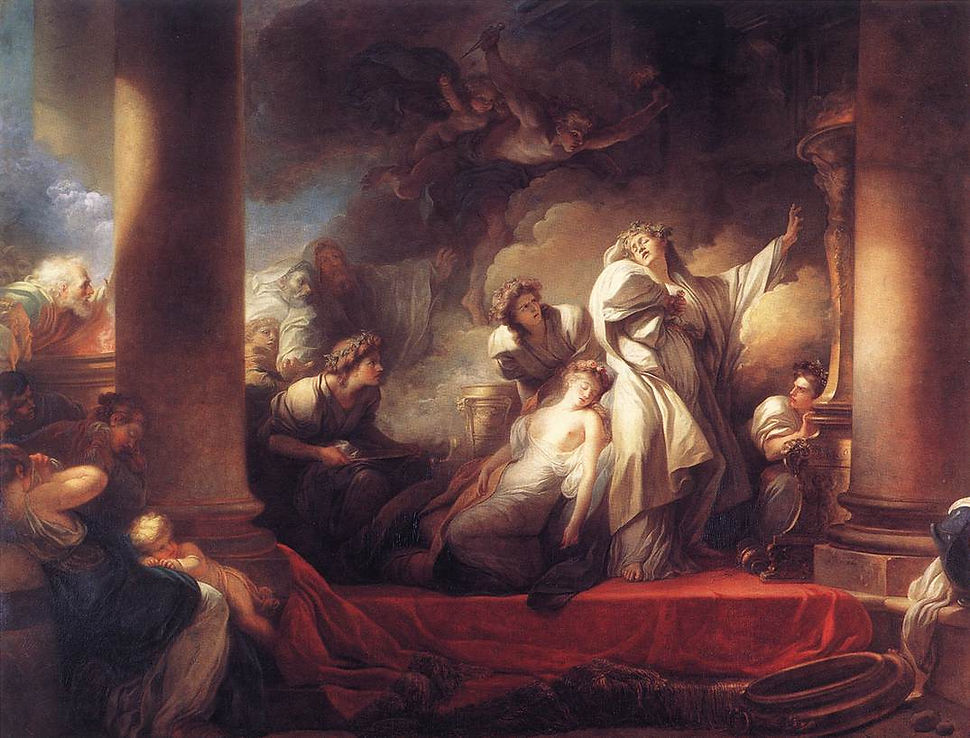
Coresus Sacrificing himself to Save Callirhoe
1765

The Swing
1767

Marie-Madeleine Guimard (Fanciful Figure)
1769

Monsieur de la Bretèche (Fanciful Figure)
1769

Young Woman Playing with a Dog
1765-72

The Shirt Withdrawn
c. 1770

Two Girls on a Bed Playing with Their Dogs
c. 1770

The Progress of Love: The Meeting
1773

The Progress of Love: The Lover Crowned
1771-73

The Bathers
1772-75

A Young Girl Reading
c. 1770
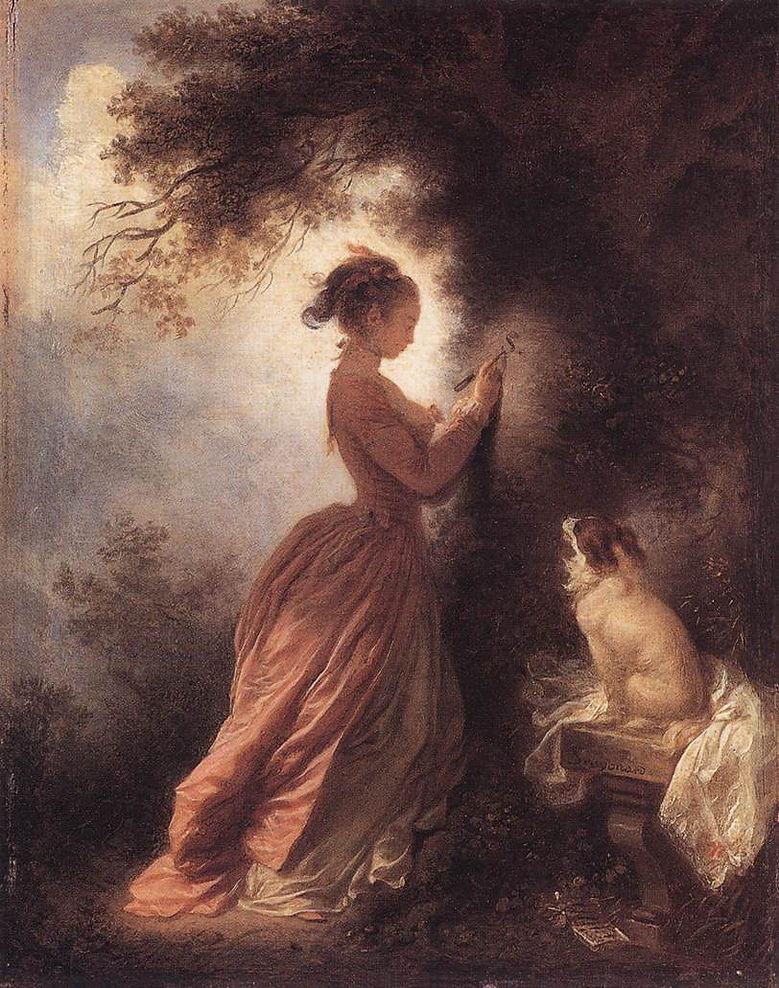
The Souvenir
1775-78

The Bolt
c. 1777

The Love Letter
1770s

The Fountain of Love
1785

The Stolen Kiss
1787-89

Blind Man's Bluff
1750–1752

The Musical Contest
1754–55

Aurora Triumphing over Night
c. 1755–56

La Gimblette
c. 1770
Louis Marin Bonnet
1736 - 1793
Louis-Marin Bonnet (French: Louis-Marin Bonnet; 1736 or 1743, Paris - October 12, 1793, Saint-Mande) - French draftsman and engraver, an outstanding master of metal engraving using the "pencil style" technique
He became famous for his color engravings reproducing drawings by A. Watteau, F. Boucher, Sh.-A. Van Loo, J.-B. Yue. Bonnet reproduced mainly complex pastel drawings, using up to eighty boards per engraving. He used opaque paints that gave a matte tone and tinted paper. He reproduced the spaces by printing with white from a separate board. This technique is called “pastel style”. In 1769, Bonnet described his technique in detail in the book “Pastel in Engraving, Invented and Executed by Louis Bonnet” (Le pastel en gravure inventé et exécuté par L. B.)

***

***

***

***

***

***

***

***

***

***

***

***

***

***

***

***

***

***

***

***

***

***

***

***

***

***

***

***

***

***

***

***

***
Louise Élisabeth Vigée Le Brun
1755 - 1842
Élisabeth Louise Vigée Le Brun (16 April 1755 – 30 March 1842),also known as Louise Élisabeth Vigée Le Brun or simply as Madame Le Brun, was a French painter who mostly specialized in portrait painting, in the late 18th and early 19th centuries.
Her artistic style is generally considered part of the aftermath of Rococo with elements of an adopted Neoclassical style. Her subject matter and color palette can be classified as Rococo, but her style is aligned with the emergence of Neoclassicism. Vigée Le Brun created a name for herself in Ancien Régime society by serving as the portrait painter to Marie Antoinette. She enjoyed the patronage of European aristocrats, actors, and writers, and was elected to art academies in ten cities. Some famous contemporary artists, such as Joshua Reynolds, viewed her as one of the greatest portraitists of her time, comparing her with the old Dutch masters.
Vigée Le Brun created 660 portraits and 200 landscapes. In addition to many works in private collections, her paintings are owned by major museums, such as the Louvre in Paris, Hermitage Museum in Saint Petersburg, National Gallery in London, Metropolitan Museum of Art in New York, and many other collections in Europe and the United States. Her personal habitus was characterized by a high sensitivity to sound, sight and smell. Between 1835 and 1837, when Vigée Le Brun was in her eighties, with the help of her nieces Caroline Rivière and Eugénie Tripier Le Franc, she published her memoirs in three volumes (Souvenirs), some of which are in epistolary format. They also contain many pen portraits as well as advice for young portraitists.

Self-portrait in a Straw Hat
1782

Self-portrait with her Daughter Julie
1786

Marie Antoinette with a Rose
1783

Peace bringing back abundance
1783

Madame Perregaux
1789

Lady Hamilton as the Cumaean Sybil
1792

Princess von Esterhazy as Ariadne
1793

Alexandra and Elena Pavlovna
1795–1797
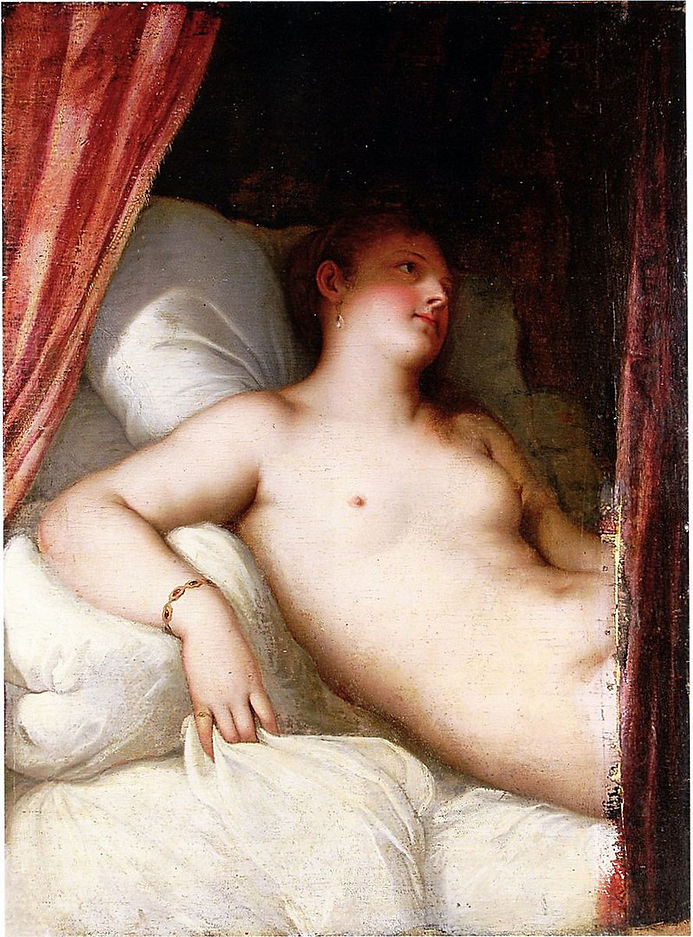
Danaë, after Titian

Madame de Staël as Corinne at Cape Miseno
1807–1809

Juno Borrowing the Belt of Venus
1781

Innocence takes refuge in the arms of Justice
1779

Duchesse de Polignac
1782

Élisabeth of France, sister of Louis XVI
1782

Marie-Gabrielle de Gramont, Duchesse de Caderousse
1784
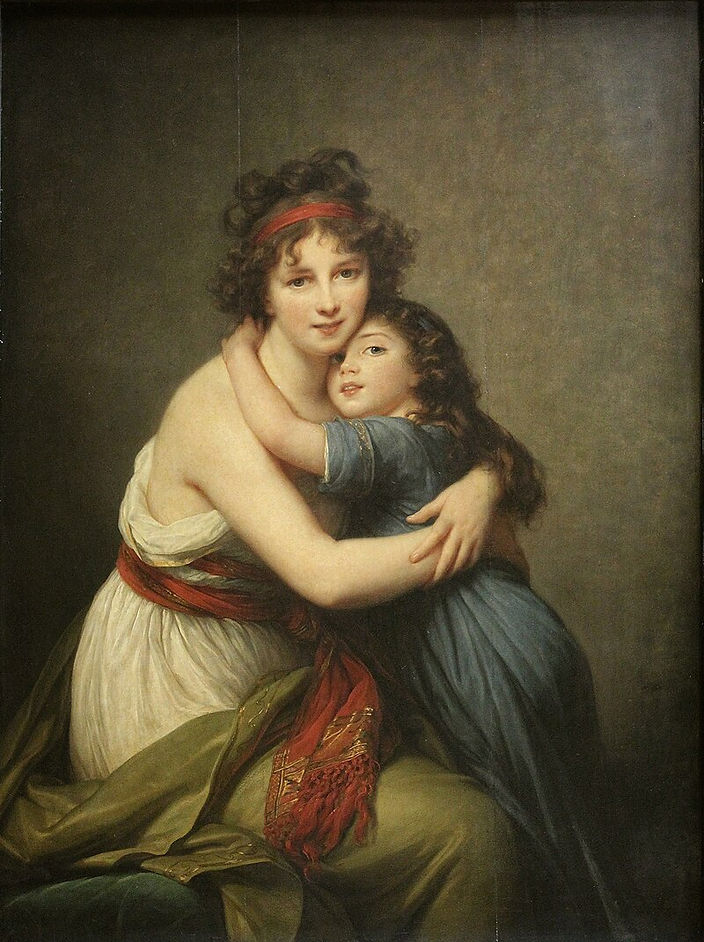
Self-portrait with her Daughter
1789

Self-portrait, painting Marie Antoinette
1790

Emma, Lady Hamilton as Ariadne
1790

Emma Hamilton as a Bacchante
1792

Julie Le Brun as Flora
1799
